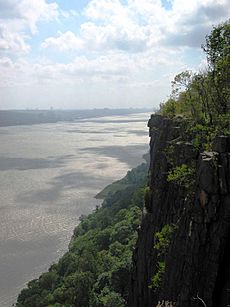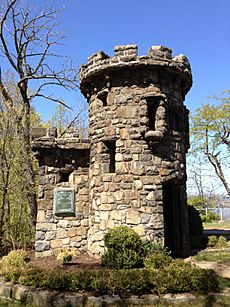Palisades Interstate Park Commission facts for kids
|
Palisades Interstate Park
|
|

|
|
| Location | Fort Lee, New Jersey northward to Palisades, New York |
|---|---|
| Built | 1900 |
| NRHP reference No. | 66000890 |
Quick facts for kids Significant dates |
|
| Added to NRHP | October 15, 1966 |
| Designated NHL | January 12, 1965 |
The Palisades Interstate Park Commission (PIPC) was created in 1900. It was started by Governors Theodore Roosevelt of New York and Foster Voorhees of New Jersey. They formed it to stop the digging and removal of rocks from the Palisades Cliffs in New Jersey.
The Palisades are tall, steep cliffs. They are also known as the New Jersey Palisades or the Hudson River Palisades. These cliffs run along the west side of the lower Hudson River. You can find them in Northeastern New Jersey and Southeastern New York. The Palisades are a special natural landmark.
After it was formed, the PIPC quickly bought land at the base of the cliffs. This helped stop the rock-digging in both New York and New Jersey. The Commission has ten members, with five chosen by each governor. The U.S. Congress approved this group in 1937. Today, the Commission manages over 125,000 acres of parkland. This includes 21 state parks, 8 historic sites, and the Palisades Interstate Parkway. More than 7 million people visit these parks every year.
Contents
History of the Palisades Park
In the late 1800s, many companies were digging rocks from the Palisades Cliffs. These companies wanted the strong rock called diabase. This rock was used to build many new buildings in nearby New York City. But many local people, like J.P. Morgan, thought this digging was ruining a beautiful natural place.
Many groups tried to save the cliffs. The most successful was the New Jersey State Federation of Women's Clubs. This group of powerful women worked hard to convince Governors Theodore Roosevelt and Foster Voorhees to protect the cliffs. Their efforts led to the creation of the Palisades Interstate Park Commission. This Commission was given the power to buy land or take it over to protect the Palisades and create a public park.
Under the leadership of George W. Perkins, the Commission began buying land. They also shut down the rock-digging operations. The Commission worked fast. They saved the land along the Hudson River from Fort Lee to the New York border. Then, they moved into New York State to Tallman Mountain, where more digging was happening. Within ten years, most quarries were closed. The Palisades Interstate Park was officially opened.
At the same time, the Commission worked to create more public open spaces. This happened in Rockland and Orange Counties, New York. A generous gift of 10,000 acres and $1,000,000 from Mary W. Harriman helped create Bear Mountain and Harriman State Parks. Today, Bear Mountain gets over 2 million visitors each year. Harriman is the second largest state park in New York.
These parks became examples for the National Park System. They are home to the first part of the Appalachian Trail. They also hosted some of the first nature trails and environmental education programs in the country.
In 1970, the New York State Office of Parks, Recreation, and Historic Preservation (OPRHP) was created. The Palisades Interstate Park Commission was then given the job of managing the Palisades Region of New York State Parks. Today, PIPC and OPRHP work together. They manage 125,000 acres of parkland in this region. This includes all state parks in Rockland, Orange, Ulster, and Sullivan Counties, New York. The Palisades Interstate Park was named a National Historic Landmark in 1965. This special area includes parks in New Jersey and New York, and Tallman Mountain State Park.
Major Welch's Contributions
In 1913, George Perkins hired Major William A. Welch as an assistant engineer. Welch later became the Chief Engineer. He helped carry out Perkins' plans for the park. After Perkins passed away in 1920, Welch became the General Manager of the Palisades Interstate Park system. He held this important job until his death in 1940.
Under Welch's leadership, the Palisades Interstate Park grew a lot. More lands were added to what are now Harriman and Bear Mountain State Parks. Other parks like Blauvelt, Tallman Mountain, Nyack Beach, and High Tor also grew.
When the park project began, there were no examples for such a big effort. Welch started a huge program to plant new trees. He also managed ten thousand workers from the Works Progress Administration and Civilian Conservation Corps. He oversaw the building of twenty-three new lakes. He also helped create 100 miles of scenic roads. Plus, he built 103 children's camps. Every summer, 65,000 city kids enjoyed the outdoors at these camps. Welch also helped start the Palisades Interstate Park Trail Conference. This group later became the New York–New Jersey Trail Conference. He even served as the chairman of the Appalachian Trail Conference.
Palisades Interstate Parkway
The idea for the Palisades Interstate Parkway began in 1933–34. It was developed by engineer and environmentalist William A. Welch. He was the general manager and chief engineer of the Palisades Interstate Park Commission. The plan was to build a parkway. It would connect the New Jersey Palisades with the state parks in Rockland and Orange counties.
Welch soon got support from John D. Rockefeller. In 1933, Rockefeller donated 700 acres of land. This land was along the New Jersey Palisades, overlooking the Hudson River. With this good start, the proposed road was accepted as a project. It was part of Franklin D. Roosevelt's New Deal coalition. However, the New Jersey Highway Commission did not support building it. So, the idea for the parkway was put on hold for a while.
In the 1940s, Rockefeller pushed for the parkway again. He worked with Robert Moses, a big park planner. They planned and designed the parkway. The original idea was for the parkway to stretch from the Garden State Parkway. It would go along the Hudson River to the George Washington Bridge. Then, it would go north along its current path, ending at the Bear Mountain Bridge. This southern part was never built.
Construction on the current parkway began in New York on April 1, 1947. Work on the New Jersey part started about a year later. Building was delayed twice because of a lack of materials. But the parkway still opened in parts during the 1940s and 1950s. The New Jersey section was finished in 1957. On August 28, 1958, the last part of the parkway was completed. This was between exits 5 and 9 in southern Rockland County.
Henry Hudson Drive
Henry Hudson Drive is a small, scenic road in Bergen County, New Jersey. It runs for 8 miles along the western side of the Hudson River. The road goes from Edgewater, New Jersey to Alpine, New Jersey. It is located at the bottom of the Palisades Cliffs, very close to the river.
The Palisades Interstate Park Commission built and takes care of this road. It was built before the Palisades Interstate Parkway, which is to its west. Even though the Parkway is now much bigger, Henry Hudson Drive is still open. It is used as a scenic road for people from New York City, Yonkers, and Washington Heights across the river. The Drive connects many picnic areas and docks to the main roads. It also goes under the George Washington Bridge. This is the only road in New Jersey that does this.
Current Park System

The park system has grown over the years. It now includes nineteen state parks and nine historic sites. These cover over 100,000 acres. They stretch along more than 20 miles of Hudson River shoreline and beyond. The Commission also manages the Palisades Interstate Parkway. This parkway was built between 1947 and 1958.
The Commission also owns four other parkways that go through its parks. Two of these are partly or fully maintained by the New York State Department of Transportation. The others are owned and maintained by PIPC.
The Palisades Interstate Park in New Jersey is about 12 miles long. At its widest point, it is about half a mile wide. The average width is about 575 yards. It covers an area of 2,500 acres. The park has uplands, cliffs, and the Hudson River shorefront. PIP has more than 30 miles of hiking and ski trails.
State Parks in the System
- Bear Mountain State Park, NY
- Blauvelt State Park, NY
- Bristol Beach State Park, NY
- Franny Reese State Park, NY
- Goosepond Mountain State Park, NY
- Harriman State Park, NY
- Haverstraw Beach State Park, NY
- High Tor State Park, NY
- Highland Lakes State Park, NY
- Hook Mountain State Park, NY
- Lake Superior State Park, NY
- Minnewaska State Park Preserve, NY
- Nyack Beach State Park, NY
- Palisades Interstate Park, NJ
- Rockland Lake State Park, NY
- Schunnemunk State Park, NY
- Sterling Forest State Park, NY
- Storm King State Park, NY
- Tallman Mountain State Park, NY
Historic Sites in the System
- Blackledge-Kearney House, NJ
- Fort Lee Historic Park, NJ
- Fort Montgomery State Historic Site, NY
- Knox's Headquarters State Historic Site, NY
- New Windsor Cantonment State Historic Site, NY
- Senate House State Historic Site, NY
- Stony Point Battlefield State Historic Site, NY
- National Purple Heart Hall of Honor, NY
- Washington's Headquarters State Historic Site, NY
Parkways in the System
 Arden Valley Road
Arden Valley Road Lake Welch Parkway (ownership)
Lake Welch Parkway (ownership) Palisades Parkway
Palisades Parkway Seven Lakes Drive (partial ownership)
Seven Lakes Drive (partial ownership) Tiorati Brook Road
Tiorati Brook Road


